Chicken Cacciatore is a one pot wonder loaded with succulent chicken and veggies bathed in a rustic, rich, herb laced tomato sauce!
Chicken cacciatore is Italian comfort food at its best. It’s flavorful, hearty, comforting and easy to make in one pot with pantry friendly ingredients! This chicken cacciatore recipe is made by browning juicy seasoned chicken then slowly braising it with carrots, onions, garlic mushrooms and bell peppers in a rich and hearty tomato sauce infused with herbs and spiked with sassy, salty capers or Kalamata olives. It’s one of the most satisfying explosions of flavor you will ever sink your teeth into. And the best part is, you can customize the chicken cacciatore recipe to suite your family with different veggies or spices. I’ve also included step-by-step photos, tips and tricks to make the best chicken cacciatore of your life! Serve this scrumptious recipe with pasta, polenta, mashed potatoes, rice or low spaghetti squash, zoodles or cauliflower mash along with some dinner rolls or garlic bread for a comforting dinner the whole family will adore!
One pot chicken dinners are always a win! Try out these favorites: chicken fricassee, one pot chicken Parmesan pasta, garlic herb chicken with scalloped potatoes, chicken Florentine, Tuscan chicken, honey mustard chicken with green beans and potatoes.
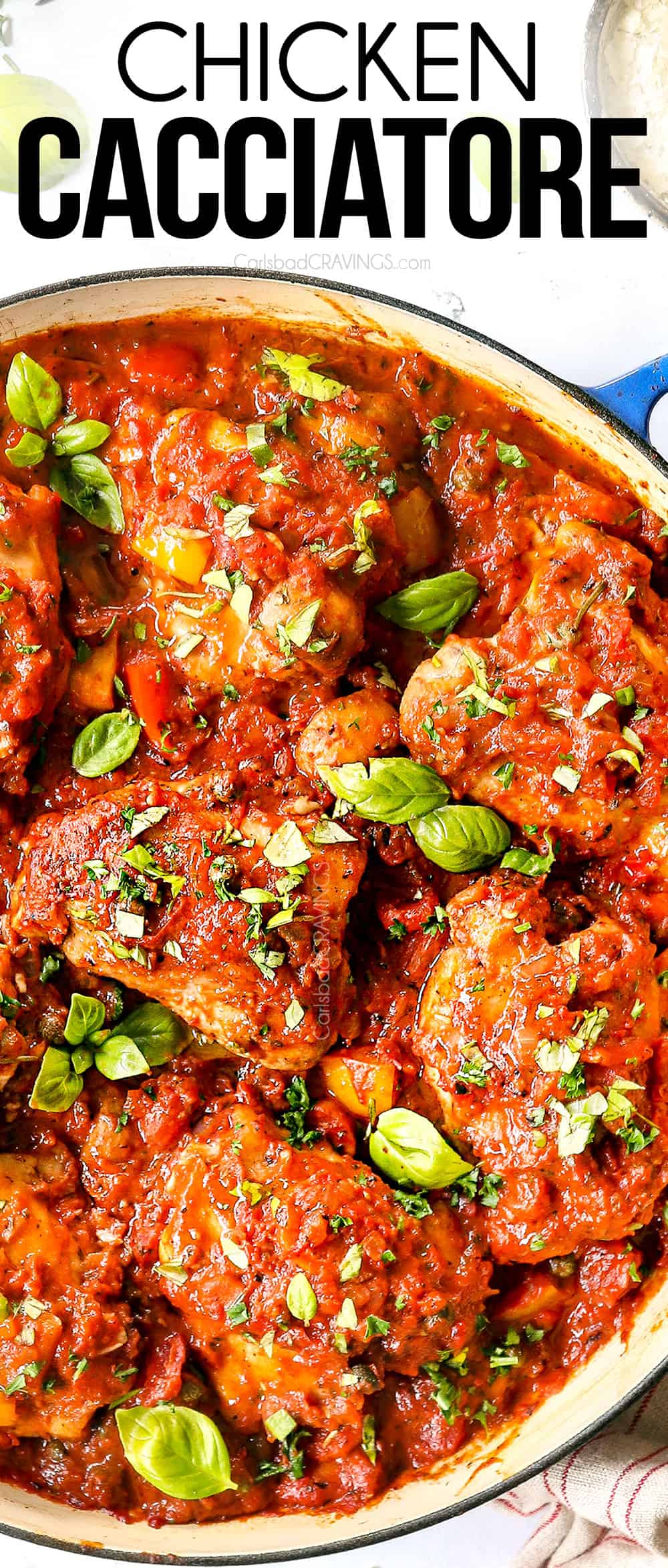
PIN THIS RECIPE TO SAVE FOR LATER
What is chicken cacciatore?
Chicken cacciatore is indeed divinely delicious, but it sounds so much fancier and more complicated than it is. Rather, chicken cacciatore is a one-pot rustic, hunter-style braised stew with chicken, tomatoes, onions, herbs, and often bell peppers, mushrooms, and either capers or olives. It is a traditional Italian dish that dates all the way back to Italy during the Renaissance period, circa 1450-1600. It has stood the test of time because it’s easy, economical, hearty and boasts big, bold flavors.
Classic chicken cacciatore is often referred to as a stew because the chicken (or rabbit) is slowly simmered until it literally is falling-off the bone directly into the sauce. Today, chicken cacciatore isn’t simmered for hours, so the chicken is still juicy, but not literally falling off the bone. You are welcome, however, to add chicken broth and simmer away!
What does chicken cacciatore mean?
Chicken cacciatore is sometimes referred to as “hunter’s stew” because cacciatore (pronounced Kah-Chuh-Taw-Ree) means hunter in Italian and alla cacciatora translates to “hunter-style.”
Cacciatore is named after renaissance hunters who would add their latest catch and any vegetables available to them to a pot to make a stew of sorts, often consisting of rabbit, tomatoes, onions, herbs, and wine. Thus, hunter style refers to a dish braised with these ingredients. Thus, chicken cacciatore means chicken that is prepared alla cacciatore or “hunter style.”
CHICKEN CACCIATORE RECIPE
This chicken cacciatore recipe is fantastically flavorful, easy, versatile and warm-you-from-the-inside-out-cozy – plus it’s served with carbs! It is simple yet layered with so many flavors from the seasoned chicken, to the aromatic onions and garlic, to the hearty vegetables, to the robust tomato sauce. In short, it’s a savory, rustic, one-pot masterpiece you need in your repertoire whether for family dinner, serving company, or simply when you’re craving comfort.
What I especially love about this chicken cacciatore recipe is that it uses every day, pantry friendly ingredients – you probably have most of the ingredients right now! You will be blown away at how the humble ingredients transform into something truly spectacular.
While this chicken cacciatore is not a 30-minute meal, it is easy and worth every second of prep before it gets popped into the oven. To make, you will dredge the chicken, sear the chicken, sauté the vegetables, add the sauce ingredients then bake. Once in the oven, all of the ingredients meld together into one savory, satisfying meal as your home fills with the intoxicating aroma of Italy. Get some pasta or potatoes (or polenta, rice, etc.) ready at the same time, and one-pot chicken cacciatore is served!
Chicken Cacciatore Ingredients
This chicken cacciatore recipe features seasoned chicken that’s coated in the most dreamy, tomato sauce. Here’s what you’ll need to make this recipe:
- Chicken: Chicken cacciatore is traditionally made with bone-in chicken thighs but you can also use a combination of chicken thighs and drumsticks because they cook in the same amount of time. Just use however many thighs/drumsticks that fit in your pot! I’ve gone into further detail about the chicken below.
- Flour: I used all-purpose flour, but I bet a gluten-free 1:1 substitute would work great.
- Spices: This chicken cacciatore recipe is packed with herbs and spices! It uses a blend of garlic and onion powder, paprika, red pepper flakes, dried basil, dried parsley, dried oregano, dried rosemary, and dried thyme. So much flavor!
- Olive oil: Use a good quality extra virgin olive oil for the best flavor.
- Butter: The onions, carrots, mushrooms and bell peppers are sautéed in both butter and olive oil for extra flavor. Use unsalted butter so you can salt to taste.
- Onion: Just one yellow onion adds a subtle sweetness to the sauce, as well as aromatic flavor.
- Carrot: Slice on the thicker side, about 1/8-inch so they don’t turn to mush.
- Bell peppers: I used a red and a yellow pepper, but use whatever you have on hand. Chop into about ½-inch squares.
- Mushrooms: I recommend white mushrooms for their mild earthy flavor so they don’t overpower the sauce. Cut the mushrooms into quarters or extra small mushrooms in half.
- Garlic: Feel free to use more garlic depending on your garlic love. If needed, you can substitute fresh garlic with 1 teaspoon garlic, or more to taste.
- Crushed tomatoes: Will often be called crushed tomatoes in puree. They provide fresh tomato flavor and texture. I recommend the brands San Marzano and Muir Glen. San Marzano tomatoes are usually sold “whole” so you will want to pour them into a bowl and crush them with your hands first.
- Fire roasted tomatoes: Are tomatoes that have been roasted, which gives them a complex sweet smokiness and are far less acidic than traditional tomatoes. Fire roasted tomatoes are located next to the traditional diced tomatoes – just make sure you purchase the ones without any added seasonings. You can use plain diced tomatoes if you can’t locate fire roasted.
- Heavy cream: Tones down the acidity and adds a splash of swanky creaminess. You may also stir in evaporated milk mixed with ½ teaspoon cornstarch.
- Tomato paste: Adds rich, concentrated tomato flavor. I store unused tomato paste by the tablespoon in the freezer for easy use.
- Capers: Add a salty, briny flavor characteristic of chicken cacciatore that cuts through the rich tomato sauce;
- Chicken bouillon: Infuses the sauce with intense flavor, just as if it had been simmering and reducing all day. You can use granulated bouillon or cubes. If using cubes, crush first but don’t add to liquid, add directly to the pot.
- Sugar: Tomatoes are highly acidic so they need to be balanced by some sugar. The amount of sugar will vary (even between the times you make it), depending on personal taste and the acidity of the tomatoes.
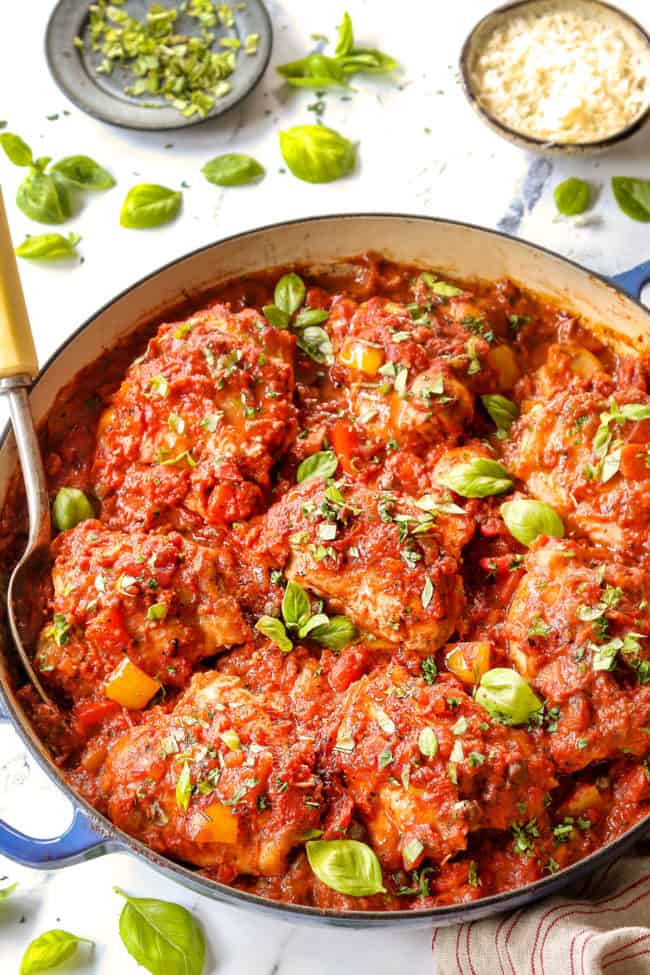
SKIN ON OR OFF?
Traditional chicken cacciatore is cooked with the skin on but I prefer to remove the skin from my chicken thighs because the skin does not stay crispy and instead turns soggy (no thank you!). The skin also leaches a lot of fat into the sauce at it cooks making it unappetizing greasy in my opinion.
To make the skinless chicken thighs just as juicy as skin-on chicken thighs, it is lightly dusted in a flour/spice coating that creates an enveloping, deeply golden, deeply flavorful crust and the chicken stays delightfully juicy and tender.
That being said, you can absolutely leave the skin on your chicken if you prefer. You will want to sear the chicken for a decent amount of time to render the fat, otherwise you will be left with extra greasy sauce.
CAN I USE CHICKEN BREASTS?
You can use boneless, skinless chicken breasts, but they will not be as juicy. If you choose to use chicken breasts, then you will want to use small chicken breasts or chicken fillets/large chicken breasts cut in half through the equator so they will cook in the allotted time. Cooking times will vary, so keep your meat thermometer handy and don’t overcook the breasts or they won’t be as juicy.
Can I add wine?
Absolutely! Add ½ cup red wine after you sauté the vegetables and simmer until it is reduced by half, stirring to scrape up browned bits on bottom of the pan.
WHAT IF I DON’T LIKE MUSHROOMS?
If you do not like mushrooms, simply leave them out or swap them for another vegetable.
CAN I MAKE IT GLUTEN FREE?
To make gluten-free chicken cacciatore, simply swap the flour with gluten free flour. The rest of the ingredients are gluten free.
WHAT OTHER VEGETABLES CAN I PUT IN CHICKEN FRICASSEE?
You can add almost any vegetables to chicken fricassee. The recommended carrots, mushrooms and bell peppers are phenomenal together but you can also swap in butternut squash, parsnips, green beans, broccoli, or cauliflower, just to name a few.
WHAT POT DO I NEED FOR CHICKEN CATTIAORE?
I use a 3 ½ quart cast-iron enamel braiser that measures 11 1/2″ in diameter by 2 1/2″ high. You will want to use a similar oven proof dish/pot with a tight-fitting lid.
If you don’t have a deep oven proof saucepan, you can you can cover and simmer on the stove for about 45 minutes or transfer the chicken and sauce to an oven safe baking dish. If you don’t have a lid, cover your oven proof dish tightly with foil. If your seal isn’t tight, then heat and liquid will escape.

How to Make Chicken Cacciatore
- Step 1 – Season Chicken: The seasoned flour coating not only insulates the chicken and keeps it more moist and tender inside but it also creates crust to carry flavor. To create the crust, mix the flour in a shallow dish with salt, pepper, garlic powder, onion powder. Pat chicken dry (so the flour will stick) then dredge each piece in the mixture. Shake off any excess flour, then transfer the chicken to a dry surface. You don’t want to return the chicken to the same surface (unless you wipe it with paper towels) because the moisture left behind from the chicken will make the coating wet and fall off.
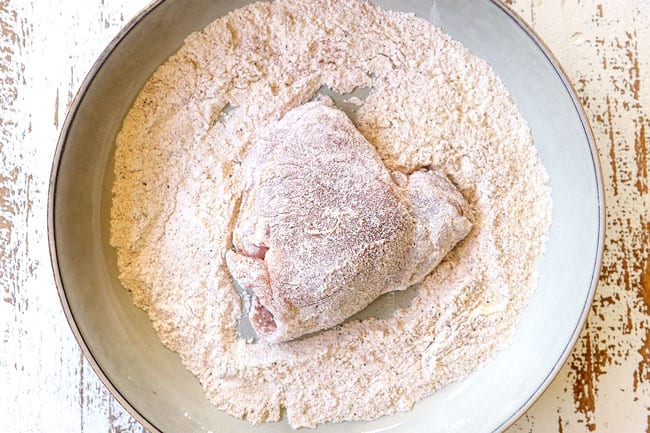
- Step 2- Brown the chicken: Add the butter and olive oil to a large skillet and brown the seasoned chicken on both sides -you’re not looking to cook it all the way through. Once browned, transfer chicken to a plate but leave whatever drippings behind. These deeply flavorful drippings will add an extra oomph of flavor to the veggies and the entire dish.
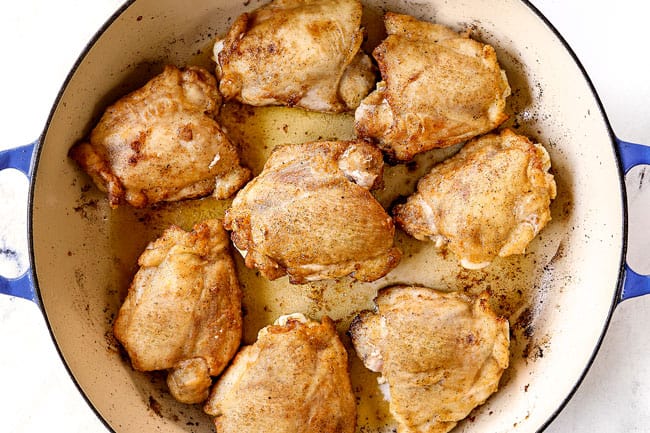
Step 3 – Sauté veggies: In the same skillet the chicken cooked in, sauté the onions, carrots, celery and mushrooms. Add a drizzle of olive oil if the vegetables become too dry. Add garlic and red pepper flakes and sauté for 30 seconds. The red pepper flakes won’t make the dish spicy, just awaken the dish a bit.
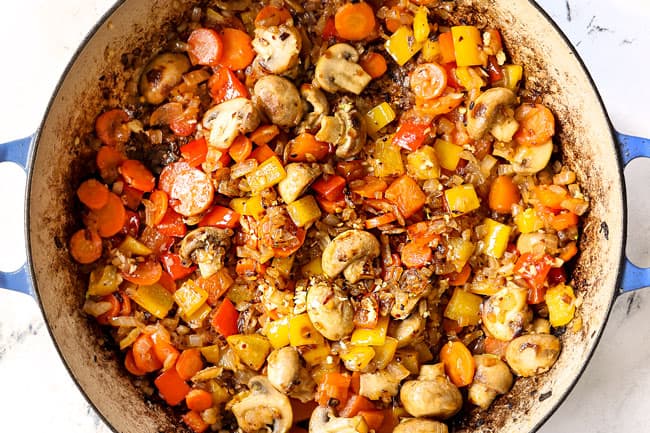
Step 4 – Make Sauce: The sauce is super straightforward – just stir in all the remaining ingredients. If you decided to use olives, you will want to add them here.

Step 5 – Bake: Return the chicken to the pot and spoon some of the sauce over the chicken to protect it. Bring to a simmer, then cover with a lid. Place the covered pot into the oven and bake at 350 degrees F for about 45-60 minutes. You want the chicken to be super tender, almost falling off the bone.
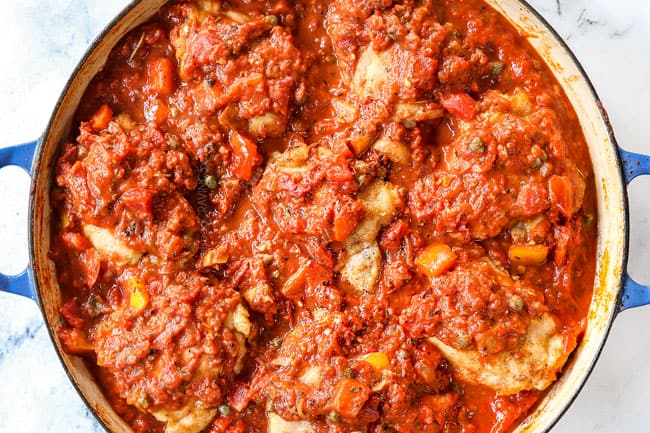
Step 6 – Garnish: Garnish with grated Parmesan and freshly torn basil leaves for an extra oomph of favor.
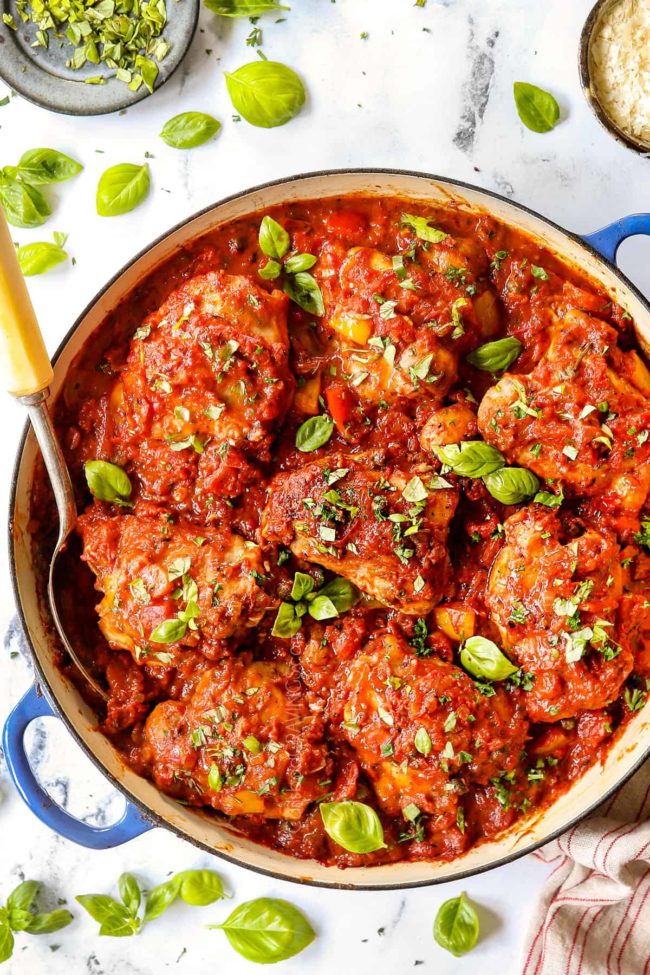
Tips for Making Chicken Cacciatore
- Use both butter and olive oil: I almost always use a combination of butter and oil whether it’s for making a roux or for pan frying chicken. The butter adds the undeniably scrumptious buttery flavor and the oil prevents the butter from burning. You may use all oil but you cannot use all butter or the butter will burn. I recommend using both for best results.
- Scrape up golden bits: After you cook the chicken, there will be golden bits on the bottom of the pan – these are flavor gold! Make sure to scrape up the bits while you sauté the veggies.
- Don’t burn chicken drippings: If your chicken drippings are turning dark too quickly, reduce the heat while searing the chicken. You want deeply golden chicken drippings. If the bits have turned black – you don’t want them! They will make your entire chicken cacciatore taste burnt.
- Use a hot pan: Add your chicken only once the pan is hot – you should hear the chicken sizzle the second it touches the pan. If you add chicken to a lukewarm pan it will not sear, and as we all know from Gordon Ramsey, color = flavor. Searing the chicken results in the Maillard reaction, also known as the flavor reaction, in which amino acids and reducing sugars produce browning and complex flavor. Note that hot doesn’t mean high heat, but it means it’s reached full temperature.
- Only flip chicken once: Adding the chicken to a hot pan is only half the battle. Resist the urge to move the chicken as it cooks or to flip it more than once. The chicken needs to stay in the same place for a continuous amount of time to brown. When the chicken is browned, it will naturally release from the pan.
- Add additional oil to veggies: The vegetables will be sautéed for about 10 minutes. If they drink up all of the oil while cooking, feel free to drizzle some more in – it will add additional flavor.
- Cook until tender: You can cook the chicken more or less depending on your desired level of tenderness. The chicken should be safe to consume after baking 25-30 minutes and become increasingly tender the longer you bake it after that. If it’s not falling off the bone like you want, simply bake on!
CAN I EAT CHICKEN WHEN IT’S PINK?
Sometimes chicken can look pin even when it is obviously cooked. Cooked chicken can still have a pink tint because young chickens (often what we purchase) have porous bones through which bone marrow can permeate, staining the adjacent meat regardless of the final internal temperature of the cooked chicken.
Myoglobin is another reason cooked chicken can sometimes look pink and the reason behind the term “dark meat.” Myoglobin is a pigmented protein that delivers oxygen to cells, the more active the part of the bird, the more myoglobin it receives. Breast meat is white because it is inactive and therefore contains low levels of myoglobin; chicken legs, wings and thighs, are “dark meat” because they contain higher levels of myoglobin because they are more active. Myoglobin can make dark meat appear pinkish when cooked because it can pool in the meat fibers when packaged.
Bottom line – be safe and use a meat thermometer and cook chicken breasts to 165 degrees F and dark meat to 170 -175 degrees F.
Recipe Variations to Try
- Heavy cream substitute: You can swap the heavy cream for evaporated milk mixed with ½ teaspoon cornstarch. Just remember that fat equals flavor so the tomato sauce won’t taste quite as decadent.
- Sour cream: You can skip the heavy cream and thicken the sauce with sour cream instead – just think beef stroganoff BUT the sour cream has to be added after the chicken is baked. You will want to remove the baked, chicken, stir in the sour cream, then add the chicken back to the skillet.
- Use cremini mushrooms: If you’re a mushroom lover and want more of a mushroom flavored sauce, swap the milder white mushrooms for cremini mushrooms.
- Swap vegetables: You can use your favorite vegetables such as butternut squash, zucchini, bell peppers, parsnips, spinach etc. If using quick cooking vegetables such as zucchini or bell peppers, don’t cook them as long as the carrots. You can also stir in spinach at the end of cooking or even try adding canned artichokes (packed in water, not brine).
- Add olives: Kalamata olives are often added to chicken cacciatore to enhance the briny flavor. You can even substitute the capers for olives if you aren’t a fan of capers or if olives are all you have on hand.
- Spice it up. Amp up the heat with additional red pepper flakes.
- Add cheese: Once the chicken is cooked, remove it from the oven and top with freshly shredded mozzarella cheese, then pop it back in the oven to melt.
Can I Prepare This Recipe in Advance?
This easy chicken cacciatore recipe does require some prep work, most of which can be done ahead of time. Here’s how:
- Chicken: Remove the skin from the chicken, dredge chicken in flour mixture and sear per recipe instructions. Transfer to an airtight container in the refrigerator for up to 24 hours. Save the chicken drippings.
- Veggies: Chop all of the vegetables and store in an airtight container in the refrigerator. You can also go one step further and sauté the veggies if you wish.
- Sauce: You can prepare the recipe all the way up through making the sauce before adding the chicken back to the pan. Store sauce (with veggies) and chicken separately. When ready to continue with the recipe, bring to a simmer, then add the chicken and pop in the oven.
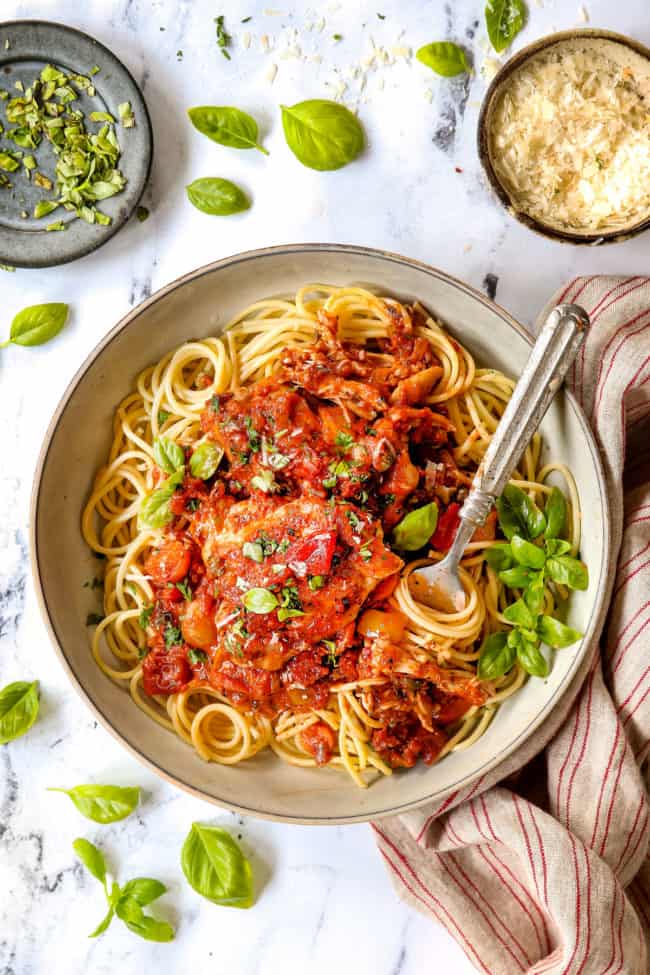
Slow Cooker Chicken Cacciatore
You can also make chicken cacciatore in the slow cooker for a lazy day meal, here’s how:
- Dredge the chicken in flour and brown per the recipe. Once golden, transfer the chicken to a lightly greased slow cooker.
- Add all of the remaining ingredients and give them a stir over top the chicken.
- Cover and cook on LOW for 7-8 hours or HIGH for 3-4 hours OR until chicken is cooked through and falling off the bone.
Stove Top Chicken Cacciatore
Prepare chicken cacciatore as instructed but instead of transferring to the oven, bring to a boil, cover and reduce the heat to low. Simmer until the chicken is tender, about 45 minutes. Halfway through cooking, move the chicken pieces around and/or turn them over to ensure even cooking.
How to Store and Reheat Chicken Cacciatore
- Storage: This chicken cacciatore can be stored in an airtight container in the fridge for four to five days.
- Microwave: I recommend choppingup the chicken so it reheats more evenly, then transferring a small portion to a microwave safe dish. Heat for 1 minute, stir, then continue to heat at 30-second intervals.
- Stove: Chop up chicken, then transfer to a skillet. Heat over medium heat, stirring often.
Can You Freeze Chicken Cacciatore?
Yes! Chicken cacciatore freezes very well. To freeze this easy chicken dinner, let it cool completely, then seal the chicken and sauce in a freezer bag or airtight container for up to 3 months. When ready to eat, place in the fridge overnight to thaw before reheating.
What to Serve with Chicken Cacciatore
This saucy chicken cacciatore recipe is begging to be served over carbs to soak up the luscious tomato sauce. We love it over:
- A bed of buttery mashed potatoes – my favorite way to serve it!
- Polenta – most traditional way to serve it
- Pasta, such as spaghetti, cavatappi penne, campanelle, fusilli, etc.
- Stuffed pastas such as ravioli or tortellini – yum!
- Rice – any kind!
- Low-carb alternative such as cauliflower mashed “potatoes,” cauliflower rice, zucchini noodles or spaghetti squash
Now that the chicken cacciatore is squared away, let’s talk sides. We love adding a fresh salad like wedge Salad, strawberry salad, or spinach Berry Salad in the spring/summer and apple salad, pear salad or beet salad in the Winter.
Lastly, bread is a must to ensure no sauce is left behind. You can serve this dish with a simple side of crusty bread, or we’re obsessed with my Garlic Bread, Dinner Rolls, or Garlic Parmesan Butter Breadsticks.
Looking for More Easy Chicken Dinner Recipes?
- 30-Minute Chicken in Mushroom Sauce
- Bruschetta Chicken
- Caprese Chicken Pasta
- Chicken Florentine
- Chicken Parmesan Pasta
- Chicken Piccata
- Creamy Tuscan Chicken and Potatoes
- Baked Parmesan Crusted Chicken
- All of my chicken recipes!
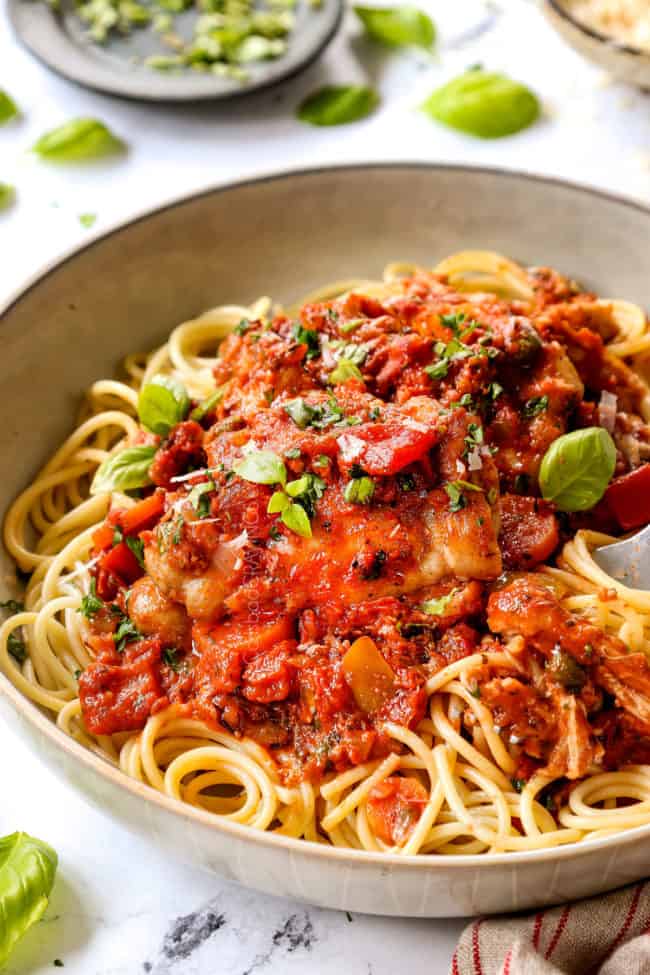
Want to try this Chicken cacciatore RECIPE?
Pin it to your Dinner or Chicken Board to SAVE for later!
Find me on Pinterest for more great recipes! I am always pinning :)!
©Carlsbad Cravings by CarlsbadCravings.com
Tools Used in This Recipe
See Favorite Tools
Chicken Cacciatore
Save This Recipe To Your Recipe Box
You can now create an account on our site and save your favorite recipes all in one place!
Ingredients
CHICKEN
- 6-8 bone-in chicken thighs, skin removed (whatever fits your pot)
- 2 tablespoons flour
- 1 tsp EACH salt, garlic powder, onion powder
- 1/2 tsp EACH pepper, paprika
- 2 tablespoon olive oil
- 1 tablespoon unsalted butter
SAUCE
- 2 tablespoons unsalted butter
- 1 medium yellow onion diced
- 1 large carrot sliced
- 1 yellow bell pepper chopped
- 1 red bell pepper chopped
- 8 ounces white mushrooms quartered or halved if small
- 4-6 cloves garlic minced
- 1/4 teaspoon red pepper flakes optional for a kick
- 1 28 oz. can crushed tomatoes
- 1 15 oz. can fire roasted diced tomatoes with juices
- 1/3 cup heavy cream
- 3 tablespoons drained capers OR ½ cup halved Kalamata olives
- 2 tablespoons tomato paste
- 2 tsp EACH dried basil, dried parsley, chicken bouillon
- 1 tsp EACH dried oregano, dried rosemary, dried thyme
- 1 teaspoon sugar more or less to taste
- salt and pepper
FOR SERVING
- Coarsely chopped fresh basil
- freshly grated Parmesan
Instructions
- Preheat oven to 350 F. Whisk flour and all "chicken seasoning" together in a shallow dish. Pat chicken dry and dredge each piece in the mixture, pressing the flour into the chicken, shake off any excess, then transfer to a dry surface.
- Melt 1 tablespoon butter in 2 tablespoons oil over medium-high heat in a deep, oven-proof skillet/braiser. Once hot, add chicken and cook approximately 4 minutes per side, until golden (it will not be cooked through) – do NOT let the drippings burn/blacken. Reduce heat if necessary. Remove chicken to a plate but do not discard drippings.
- Reduce heat to medium. To the now empty skillet, melt 2 tablespoons butter. Add enough olive oil to equal 2 tablespoons when combined with the drippings (eyeball it).. Add onions, carrots, bell peppers and mushrooms and cook until softened, about 10 minutes. Add a drizzle of olive oil if the vegetables become too dry. Add garlic and red pepper flakes and sauté for 30 seconds.
- Stir in all remaining ingredients up to “for serving.” Season with salt and pepper to taste. Return chicken pieces to the skillet along with any juices and spoon some sauce over the top.
- Bring to a simmer, cover, and bake at 350 degrees F for 45-60 minutes, until the chicken is cooked through and fall apart very tender.
- You can shred the chicken in the sauce or serve it whole with the sauce spooned over top. Serve chicken cacciatore over pasta, potatoes, rice, polenta, or veggie noodles, with freshly chopped basil and freshly grated Parmesan.
Notes
TIPS FOR SUCCESS
- Pot size: I use a 3 ½ quart cast-iron enamel braiser that measures 11 1/2″ in diameter by 2 1/2″ high. You will want to use a similar oven proof dish/skillet with a tight-fitting lid. If you don’t have an oven proof skillet, you can transfer the chicken and sauce to an oven safe baking dish, just be aware baking times will vary. If you don’t have a lid, cover your oven proof dish tightly with foil. If your seal isn’t tight, then heat and liquid will escape.
- Skin on or off? Traditional chicken cacciatore is often cooked with the skin on but I prefer to remove the skin from my chicken because the skin does not stay crispy and becomes unappetizingly soggy skin. To make the skinless chicken just as juicy as skin-on chicken, it is lightly dusted in a flour/spice coating that creates an enveloping, deeply golden, deeply flavorful crust and the chicken stays delightfully juicy and tender. You can leave the skin on your chicken if you prefer just make sure to sear the chicken for a decent amount of time to render the fat, otherwise you will be left with extra greasy sauce.
- Chicken breasts: Won’t be as juicy or flavorful but can still be used. Cooking time will vary depending on the size of your chicken breasts. Make sure they are submerged in the sauce so they don’t dry out when baking.
- Capers: Add a salty, briny flavor characteristic of chicken cacciatore that cuts through the rich tomato sauce. You may substitute them with ½ cup pitted, halved Kalamata olives.
- Chicken bouillon: Infuses the sauce with intense flavor, just as if it had been simmering and reducing all day. You can use granulated bouillon or cubes. If using cubes, crush first but don't add to liquid, add directly to the pot.
- Wine: If you’d like to use wine, add ½ cup red wine after you sauté the vegetables and simmer until it is reduced by half, stirring to scrape up browned bits on bottom of the pan.
- Swap veggies: You can add almost any longer cooking vegetables to this recipe such as butternut squash, parsnips, green beans, broccoli, or cauliflower, just to name a few.
- Gluten free: To make gluten-free chicken cacciatore, simply swap the flour with gluten free flour. The rest of the ingredients are gluten free.
Prep Ahead
- Chicken: Remove the skin from the chicken, dredge chicken in flour mixture and sear per recipe instructions. Transfer to an airtight container in the refrigerator for up to 24 hours. Save the chicken drippings.
- Veggies: Chop all of the vegetables and store in an airtight container in the refrigerator. You can also go one step further and sauté the veggies if you wish.
- Sauce: You can prepare the recipe all the way up through making the sauce before adding the chicken back to the pan. Store sauce (with veggies) and chicken separately. When ready to continue with the recipe, bring to a simmer, then add the chicken and pop in the oven.
How to Store and Reheat
- Storage: This chicken cacciatore can be stored in an airtight container in the fridge for four to five days.
- Freezer: Let it cool completely, then seal the chicken and sauce in a freezer bag or airtight container for up to 3 months. When ready to eat, place in the fridge overnight to thaw before reheating.
- Microwave: I recommend chopping up the chicken so it reheats more evenly, then transferring a small portion to a microwave safe dish. Heat for 1 minute, stir, then continue to heat at 30-second intervals.
- Stove: Chop up chicken, then transfer to a skillet. Heat over medium heat, stirring often.
Slow Cooker Chicken Cacciatore
- Dredge the chicken in flour and brown per the recipe. Once golden, transfer the chicken to a lightly greased slow cooker.
- Add all of the remaining ingredients and give them a stir over top the chicken.
- Cover and cook on LOW for 7-8 hours or HIGH for 3-4 hours OR until chicken is cooked through and falling off the bone.
Stove Top Chicken Cacciatore
Prepare chicken cacciatore as instructed but instead of transferring to the oven, bring to a boil, cover and reduce the heat to low. Simmer until the chicken is tender, about 45 minutes. Halfway through cooking, move the chicken pieces around and/or turn them over to ensure even cooking.
Did You Make This Recipe?
Tag @CarlsbadCravings and Use #CarlsbadCravngs
Leave a Review, I Always Love Hearing From You!
Carlsbad Cravings© Original
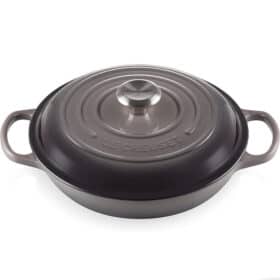
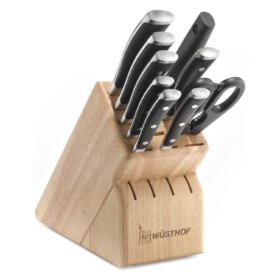


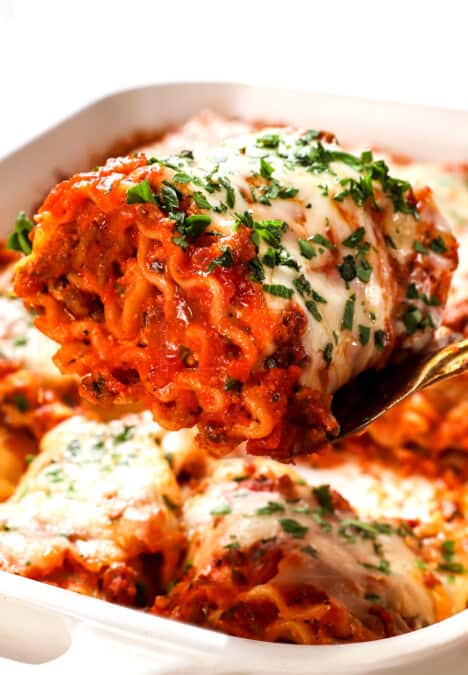



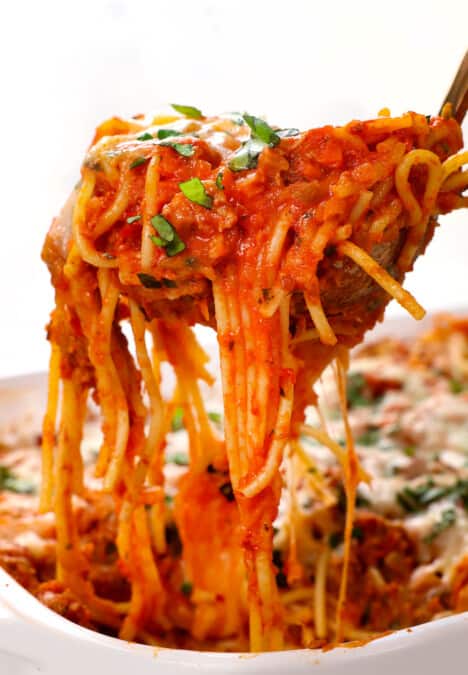
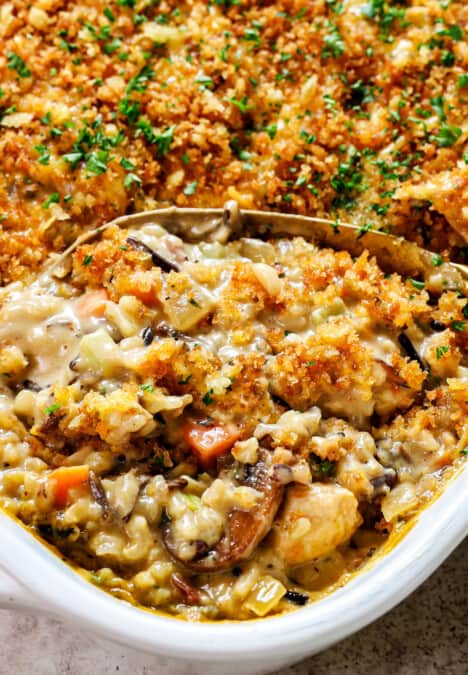























Patti says
I just recently discovered your blog. Thanks so much for the time and heart that you put into your recipes. I really appreciate the detailed suggestions. I’m excited about trying some new recipes from your blog!
Jen says
Welcome to my site Patti, I’m so happy to have you! I’m so glad you find the info helpful! I hope you find many new favorites here!
Susan says
This looks delicious. I usually buy boneless thighs so do I just cut down on oven cooking time?
Jen says
Yes, those will still work great, maybe try 35 minutes?
Anne-Louise Hill says
Absolutely delicious. The Kalimantan olives, the wine made for your usual complex flavor combo.
Five stars as usual
Jen says
Thank you so much, I’m so pleased you loved it!
Richard Tunner says
This was sooo good! I used boneless skinless chicken breasts and followed the recipe otherwise exactly. I let it simmer on the lowest setting for 2 hours and that chicken was the most tender flavorful chicken I’ve ever had. Absolutely delicious!
Jen says
Thank so much Richard, I’m so pleased you loved it and were able to use chicken breasts!
Diana says
I’ve made this several times. I don’t see that I ever left a review, but my family loves it.
Today, I was making a different recipe from another recipe blog that calls for skin-on/bone-in thighs. I thought to myself, “Every time, I make skin on/bone-in chicken, all my hard work on the marinade or sauce gets lost in the soggy skin that nobody eats.”
Then I remembered the trick you taught me here – about de-skinning the chicken and dredging it in a flour mix. Worked beautiful. Thank you.
Jen says
You are so welcome, Diana! I am so pleased your family loves it and that my trick worked for you! I hope you have a fabulous weekend and find more recipes to enjoy!